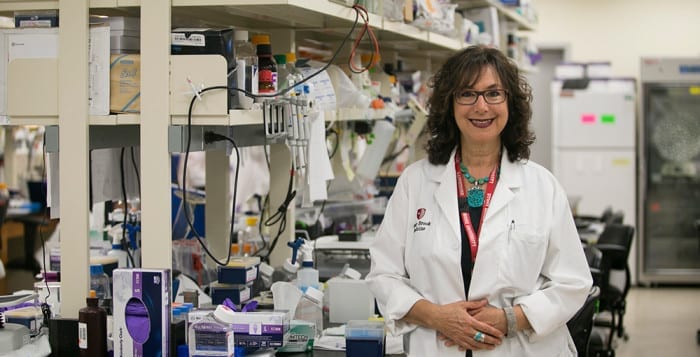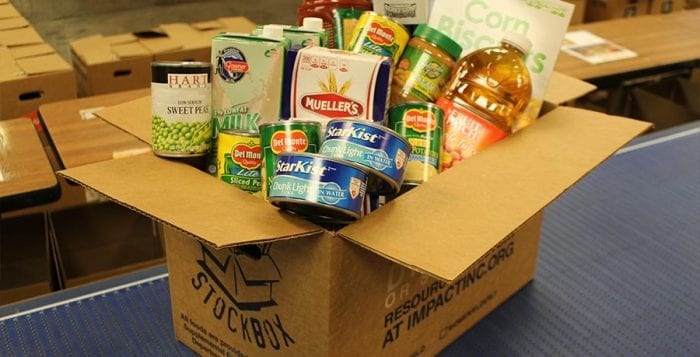Gyrodyne Subdivision Plans up for Review
Developers of the Gyrodyne complex in St. James are moving forward with plans to subdivide and potentially develop the 75-acre site known as Flowerfield. The Town of Smithtown Planning Board will consider a nine-lot subdivision for the complex at its Dec. 11 meeting.
“The Town Environmental has found the Draft Environmental Impact Statement to be complete and is preparing a resolution for the Planning Board to accept the DEIS as complete at their next meeting on Dec. 11,” said Peter Hans, director of the town planning department.
The 2,900 page statement is not yet publicly available. Once the Planning Board accepts the report as complete, likely at the Dec. 11 meeting, the document will be posted online and the public comment period will begin.
Subdivision plans obtained from the Town indicate that the proposed development is extensive. The 75-acre complex currently includes a catering hall, existing light industrial buildings and open space. The proposal subdivides the lot into nine parcels that include one for the existing catering hall, one for the industrial building and a third for open space. Six of the nine proposed sublots would be for new development. Development plans include a 150-room hotel with a restaurant and conference hall, two large-scale medical office parks, one at 75,000 square feet and another at 55,000 square feet, plus two separate 110-unit assisted living centers and a 7-acre sewer treatment facility.
If approved, the project will become one of the largest commercial transformations in an otherwise residential and agricultural setting along Route 25A in the St. James hamlet.
New York State Assemblyman Steve Englebright (D-Setauket) said the project, if approved, is a real threat to the quality of life in this area of the North Shore, with traffic being the more immediate concern and water quality threatened over time.
“This project is a real threat to the water chemistry of Stony Brook Harbor,” he said.
He estimates that the treated sewage from the site would upwell into the harbor within two to five years. Aside from the environmental and water quality concerns, Englebright said that the project is a classic case of proposed overdevelopment.
“The whole thing is a complete traffic nightmare,” he said. “Roadways are oversubscribed. Route 25A is already crowded and by extension, we find that Stony Brook Road just can’t handle any more traffic.”
The area, the assemblyman said, is not really a heavy development zone.
The property is zoned light industrial, or LI. It does not require a zone change, town officials said, since the identified uses are conceptual at this time. If the developers decide to move forward with a hotel or assisted living facility, those uses would require Special Exception approvals from the Town Board and site plan approval. Office buildings would require only site plan approval.
Englebright encourages people to express their concerns and appeal to the decision-makers in Smithtown.
The subdivision process began when the Smithtown Planning Board adopted May 9, 2018, a State Environmental Quality Review Act Positive Declaration. The declaration, which is simply a determination that the project has the potential to result in a significant environmental impact, establishes that an Environmental Impact Statement would be required. The applicant has now completed a Draft Environmental Impact Statement. The Planning Board is expected to accept the report as complete at its next meeting. The Town will then file with New York State Department of Environmental Conservation a Notice of Completion of a DEIS. The filing of the Notice of Completion opens the public comment period, which has to run at least 30 days. The Town anticipates that the Planning Board will hold a public hearing on the Gyrodyne DEIS in January.
Following the close of the public comment period, a final DEIS will have to be prepared that responds to the comments received, and then the Planning Board would have to adopt a findings statement. The Planning Board will not be able to act on the pending subdivision until the FEIS and Findings Statement have been adopted. The process, though, is months away.
Representatives from Gyrodyne did not respond to telephone messages before going to print.
Photo by Heidi Sutton
Lina Obeid, Renowned Award-Winning SBU Scientist
An award-winning scientist, grandmother, aunt, mother and wife, Dr. Lina Obeid, died Nov. 29 at the age of 64 after a recurrence of lung cancer.

Born in New York and raised in Lebanon, Obeid was a State University of New York distinguished professor of medicine and the dean of research at Renaissance School of Medicine at Stony Brook University, where she conducted research on cancer and aging. In 2015, she was named as one of The Village Times Herald’s People of the Year along with her husband Dr. Yusuf Hannun.
A Celebration of Life memorial service for Obeid will take place Dec. 7 at Flowerfield in St. James from 11 a.m. until 2:30 p.m. and will include remarks and a reception. Attendees are encouraged to wear bright colors.
SBU faculty appreciated Obeid’s scientific, administrative and mentoring contributions, as well as her engaging style.
Michael Bernstein, interim president of SBU, said Obeid was “very well liked and respected” and that her loss leaves a “big hole” at the university.
Obeid “oversaw our research programs, specifically the core facilities on which all our laboratory scientists depend, for sample analysis, for microscopy of cells” among other areas, Dr. Kenneth Kaushansky, dean of Renaissance School of Medicine wrote in an email.
He lauded Obeid’s personable approach, which he said, “rubbed off on many people,” creating a “renewed sense of optimism in our ability to impact all three missions: research, teaching and clinical care.”
Obeid and Hannun, who is the director of the Stony Brook Cancer Center, knew each other in high school, started dating in medical school and were married for 36 years. The couple recently shared a Lifetime Achievement Award at the 16th International Conference on Bioactive Lipids in Cancer, Inflammation and Related Diseases in October. The award represents the first time a woman received this honor.
Supriya Jayadev, who was a graduate student in Hannun’s lab at Duke University and is the executive director of Clallam Mosaic in Port Angeles, Washington, called Obeid a “role model” for women in science. “Not only was she a strong leader with the ability to compete in a male-dominated field, but she retained her femininity and grace.”
Daniel Raben, a professor of biological chemistry at Johns Hopkins Medicine, has known Obeid and Hannun for more than two decades.
“She had a huge impact on the sphingolipid field because of the contribution she made,” Raben said. “It’s a huge loss. She was a giant.”
Dr. Maurizio Del Poeta, a professor in the Department of Microbiology and Immunology at SBU, knew Obeid since 1995.
“I once asked her if she had any advice for my grants to get funded,” he recalled in an email. Obeid suggested she didn’t know how to get funded, but that his work wouldn’t get funded if he didn’t submit proposals.
She “never took ‘no’ for an answer. She would insist and insist and insist again until she [would] persuade you and get a ‘yes,’” he added.
Del Poeta said Obeid did a “marvelous” job enhancing research facilities, while she was a “caring physician” for veterans at the Northport VA Medical Center.
Obeid and Hannun were co-directors of a National Institutes of Health program in Cancer Biology and Therapeutics, which this year received a grant renewal for another five years.
Obeid’s daughter Marya Hannun recalled her mother as “warm, honest, and funny” without being cynical. Marya said her mother cared about everyone around her and was rooting for them to succeed.
“During my childhood, she taught me that nothing was impossible if you are determined and gutsy.”
— Mayra Hannun
“During my childhood, she taught me that nothing was impossible if you are determined and gutsy,” Marya Hannun wrote in an email.
She suggested her mother was passionate about food, which shaped how they lived and traveled. When the family visited Greece, Obeid swam out for sea urchins, cracked them on rocks and ate them on the beach. She was a passionate cook who learned from her mother, Rosette, who wrote a Palestinian cookbook.
The Hannun family laughs “about how we plan out holidays around food and spend
our meals talking about the next meals,” Marya wrote.
Obeid was part of one of the first class of women admitted into the International College High School. She earned her bachelor of arts at Rutgers University, but was also creative as a child and interested in fashion and design.
“Anyone who [saw] her wouldn’t be surprised,” Marya said.
Obeid is survived by her husband, her parents, Rosette and Sami, her nieces and nephews, her triplet children and her two grandchildren.
Obeid and Hannun’s daughter Reem is married to Dr. Khaled Moussawi and lives in Baltimore. Awni and his wife Kathy Hannun have two children, Evelyn and Yusuf, and live in New York City.
Binks Wattenberg, a professor in the Department of Biochemistry and Molecular Biology at Virginia Commonwealth University, believes that “people like [Obeid] only come along a few times in one’s lifetime.”
In an email, he recalled how she had a
“way of looking into your eyes and persuading you to do an experiment that she thought absolutely had to be done.” He appreciated her enthusiasm, which made Wattenberg feel as if he was doing “absolutely
essential work.”
Obeid regularly invited her researchers for meals at her house, where they felt as if they also joined the family, said Dr. Gerard Blobe, a professor of medicine at Duke University School of Medicine who earned his doctorate in Yusuf Hannun’s lab over 20 years ago.
In lieu of flowers, the family has asked for donations in Obeid’s name to the Stony Brook University Cancer Center. Potential donors can access the site at cancer.stonybrookmedicine.edu/giving.
Open Mike: Some inspiration (from my second family)
By Michael Tessler
I’m writing this from about 34,000 feet in the air. There’s a great landscape below me: America. This vast and beautiful country feels endless from this vantage point. No matter how old I get or how many times I take the voyage, I’ll never quite get over the fact that you can start your day on Main Street, Port Jefferson and end it on Hollywood Boulevard.
It has been a record amount of time since I’ve had a day off. Not that I’m counting. I’m nearing one month since I’ve had one truly mindless or menial day. I’m not complaining — working in Los Angeles is a blessing. Though it is a constant hustle to survive, this struggle has made me grateful for the many blessings in my life and the many people that have gotten me here.
It is easy to forget the power of the written word. Being back on Long Island for a few days, I was reminded of its incredible power by my co-worker Liz (you may know her as the bubbly sales representative who is constantly in motion). After reading my column on my weight loss journey, she began a daily routine of walking FIVE MILES every morning. You can imagine my shock, surprise and gratitude when I heard that just a few small printed letters could cause such a positive and lasting impact on someone.
So here I am, hoping I can provide some inspiration to you by sharing some lessons I was reminded of during my few days back with TBR News Media.
Local news is the beating heart of a community. Most of us take it for granted. Until I worked for the paper, I know I certainly did. That all changed after spending time with our publisher, Leah Dunaief, who at each editorial and sales meeting reminds us of the importance of the work we do and what it means to the community we serve. Leah taught me that anything can become an inspiring and exciting subject, with enough passion and pride.
There is a sense of belonging and place that comes with the printed word. When we set aside the digital drabble of social media and open the pages of our hometown paper, we’re reminded of how special we are. Whether happy or sad, tragic or celebratory — this publication tells our story and brings us together in the process.
We write lengthy and ever-amusing responses to the stories we disagree with. With great, rambunctious passion we debate parking meters and zoning laws. It may seem simple or even small, but hovering above the great American landscape I can’t help but think of how beautiful it is, this weekly celebration of us.
So as I reach the conclusion of an incredibly difficult and humbling stretch of work, riddled with successes, failures, lessons learned both easy and hard, I am reminded of the lessons taught to me by my second family at TBR News Media. Love what you do. Love who you work with. Love the community you call home and love yourself enough to take time off.
To Leah, who has believed in me and provided me with more opportunity than any person I’ve ever known: Thank you. You challenge me constantly to dream bigger, think smarter and cherish the people around me.
To Kathryn, who taught me the value of hard work and building lasting, meaningful relationships. You gave me my hustle and drive and reminded me to appreciate just how cute the little ones in our life are.
To Meg, who reminds me that to change a person’s day all you need is a smile and song, you warm every room you enter with your kindness.
To the entire TBR family, you remind me that home is always waiting for you and filled with love … no matter how far you may roam or how long.
To the readers who keep this heart beating, I’m thankful. May the love that goes into each page of this paper transcend into your home this holiday season. Merry Christmas, Happy Hanukkah and a Happy New Year from a grateful native son living his Hollywood dream.
The author is an award-winning film and television producer and CEO of Multihouse Entertainment in Los Angeles.
Setauket Fire Commissioner Candidates Talk Finances, Paid Firefighters
On Tuesday, Dec. 10, Setauket Fire District residents will choose between two candidates for a five-year term as fire commissioner, incumbent Kevin Yoos and challenger Billy Williams.
The race began with four candidates, but two petitions from volunteer firefighters Tom Gulbransen and Fred Leute were disqualified by the district. Gulbransen initially planned to continue to run as a write-in candidate but later said he has pulled out of the race entirely.
In the Setauket Fire District, the addition of three paid firefighters in 2018 has weighed heavily on many volunteers’ minds, and both candidates are looking to work to boost morale while recruiting and retaining volunteers.
Meet the candidates
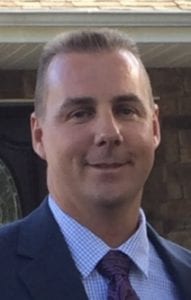
Incumbent Kevin Yoos
Fire commissioner Kevin Yoos, 49, has served one partial and one full-term and has been a volunteer firefighter for the Setauket Fire Department for 31 years.
The lifelong Three Village resident and his wife, Lisa, have two daughters in college. He recently retired after 24 years as a lieutenant of Squad Company 270 with the New York City Fire Department, which he joined after a short stint with the New York Police Department. His firehouse in South Queens responds to some 300 fires a year. He is a risk control consultant for fire department insurance and teaches at the Suffolk County Fire Academy of Yaphank as well as the New York State Academy of Fire Science.
He became involved in the Setauket Fire Department 31 years ago after watching his father, who joined in 1973 and was a former commissioner, respond to emergency calls. Yoos was 14 when he joined the junior fire company, and in 1988, at the age of 18, he joined as a full member. He has served as lieutenant captain, assistant chief and chief of department twice.
He said with a lot on his plate, he came close to not running again, but when he decided to retire, he had a conversation with his wife who agreed that with him now having more free time on his hands, he should run again.
“It’s in my blood,” he said. “It’s never going to go away.”
Challenger Billy Williams

Billy Williams, 52, is a State Farm Agent in Setauket. He and his wife Denise have four children — three in college and one in ninth grade. Williams moved to Stony Brook in 1998.
Watching his grandfather and uncles in the Southold department, he said he always wanted to be just like them. Having grown up in Syosset, he applied to FDNY but it took a few years before he was accepted, and by that time he was married in Florida with a business and was unable to join. When he moved back to New York, his office was in White Plains for more than 10 years, and when he moved his office to Setauket, closer to home, the first thing he did was sign up to volunteer.
A six-year volunteer with the department, Williams said he wants to get spending under control and manage the assets they have as well as raise morale while working on recruitment and retention. He added that being a fireman has nothing to do with being a fire commissioner, who helps to run the business side of things.
“The chiefs and the department take care of the day-to-day operations of putting out the fires and getting the ambulance,” Williams said. “The commissioners do what’s in the best interest of the taxpayers.”
Finances
Williams said there is a need for leadership to run the business end and bring the departments and the district back together, adding he feels with running a business since 1994 and managing employees and balancing budgets, he would be an asset to the district. In addition to his work in the insurance industry, he is the president of the Three Village Kiwanis Club and on the board of the local chamber of commerce. He said he also helped to bring back annual events, including the Three Village Electric Holiday Parade which was on hiatus for a year.
“I just think I know what the community needs and what the department needs,” he said. “So, I’m the guy.”
Williams said the district spent $4.8 million net in 2015 and $8.1 million net in 2019 and there will be a $300,000 increase in 2020. He said with construction on the Main Street firehouse and the purchase of new fire trucks and brand new radios he doesn’t know how commissioners can say it will not affect residents.
“I don’t know what they’re doing, but you don’t increase your spending by about 70 percent and say that taxes are going to stay the same and that there’s going to be no cost,” Williams said.
Yoos said there was an increase in taxes a few years back after residents approved the bond for the new headquarters building on Main Street. In addition, new portable radios, radio infrastructure, air packs, stretchers for the ambulances, added law-mandated cancer insurance for the volunteers and other items were purchased.
“The equipment replaced was costing a lot to try to maintain and becoming less reliable and unsafe for members to operate,” Yoos said.
He added that the public referendum vote for a municipal lease/purchase agreement for new fire trucks will be supplemented by funds that were put in the reserve account.
“Purchasing these vehicles in bulk in this manner is saving the community approximately $400,000,” he said. “Since the money is already allocated for the reserve account for vehicles the payments for the new engines will come out of this line item. So there will be no increase to taxes for the purchase.”
When it comes to fire services, Yoos said he and other commissioners do a lot of reading and research when it comes to trends and statistics. And at times, revisit decisions.
“As we continue to pay off the bond, we will continually revisit the budget requirements, and it is very likely we will be able to reduce taxes while maintaining the same level of service,” Yoos said.
Paid firefighters
Last year the Setauket Fire District changed paid fire coordinator positions into paid firefighters, a move that many, including Williams, said has hurt the morale in the departments.
He said while he believes the hybrid that exists right now is a good mix, he doesn’t want to see it become all paid, which he believes the current leadership wants, because he said he feels there’s no need for it with Setauket responding to more EMT calls than fires.
“We’re spending money that we don’t need to spend, in my opinion,” he said.
Yoos said it’s not true that the board wants a paid department.
“If we can handle this 100 percent as volunteers, we’re all in,” Yoos said. “The problem is our volunteers are dwindling, and we need to rebuild that somehow.”
Yoos said he hopes to make a better environment for the volunteers but going forward with the few paid firefighters was something they had to do at the time. The number of volunteers has dwindled while the amount of alarms continue to increase, he said. When he started in 1988, there were 180 members with a waiting list for those who wanted to be volunteers, and most members were firefighters with only a few members as EMTs. Today there are 59 interior firefighters, out of 109 active members, that can go inside a structure and put a fire out, whereas others can only assist outside.
“I love the volunteer fire service,” Yoos said. “We want to promote it more. We want more volunteers, but everybody is busy.”
He said the addition of paid firefighters was around $20 to $30 a year per household.
Williams said the district needs to put in some work to boost morale.
“Once they know that we’re not fast forwarding to becoming a fully paid department is one way,” he said, adding that more recruitment and retention efforts would help.
The election for one fire commissioner for a five-year term in the Setauket Fire District will take place Tuesday, Dec. 10, between 2 p.m. and 9 p.m. Residents can vote at the 394 Nicolls Road firehouse.
Editorial: Give well
The season for giving is here, and while North Shore residents plan their holiday feasts, it’s a good time to consider the plight of people less fortunate.
Imagine, more than 89,000 children on Long Island are hungry, according to Hauppauge-based Long Island Cares. These children aren’t dreaming of visions of sugarplums, they are wishing for substantial meals to get them and their families through the day.
Some centers, such as the Community Food Council on East 5th Street in Huntington Station, are reporting a 33 percent increase in demand over the last three months. It’s unclear why the sudden surge in food insecurities but the food banks are in need of supplies and volunteers, and counting on the local community to find ways to pitch in. So, it’s a good time to develop a plan.
When preparing to donate to a food bank, a good rule of thumb is to call the nonprofit or visit its website to see what is needed. During this time of year, many have volunteers on hand to put together holiday meals. Throughout the year, depending on donations, there may be a surplus of one item and a deficit of another.
While many may be inclined to reach into their pantry to find nonperishables, a cash donation can often be the most beneficial to nonprofits, so they can turn around and buy food in bulk. This can also save volunteers time, because they don’t need to go through items looking at expiration dates.
If one wants to donate food, a trip to the supermarket is the best bet to ensure the donated items aren’t expired. Though if your cabinets are bursting at the seams, reach in and make sure to check expiration dates on cans and boxes. Also, look cans over to ensure they are not dented or leaking and that boxes aren’t damaged. And steer away from food in glass jars as these containers can easily break.
Take into consideration more nutritious options, too, such as cereals high in fiber, whole wheat pasta and low sodium soups and vegetables. When it comes to any kind of mixes, remember many households may be out of milk or eggs, so choose a mix that can be used with water. Another thing to consider is purchasing toiletries such as toothpaste, deodorant, diapers and toilet paper.
To increase the spirit of giving, organize your local Boy Scout and Girl Scout troops or religion classes or get your children involved. Or, if you already know of a group organizing a food drive, contribute your items to the event. Collecting food for those in need is a wonderful way to inspire young ones to help others and it encourages them to continue charitable pursuits when they reach their goals or succeed them.
In our coverage area, in addition to Long Island Cares and the Community Food Council, there are the Smithtown Emergency Food Pantry, St. Anthony of Padua R.C. Church in Rocky Point, St. Cuthbert’s Episcopal Church in Selden, Ecumenical Lay Council Pantry through the First Presbyterian Church in Northport, St. Gerard Majella R.C. Church in Port Jefferson Station, Our Daily Bread Food Pantry in Setauket and many more.
As the lights come down in a few weeks, remember when it comes to food banks, the hungry keep coming. The spirit of giving can last all year round as these organizations are always in need of donations no matter what month on the calendar.
The gift of time, too, is also a generous way to contribute.
D. None of the Above: This play offers a lighthearted respite from political headlines

By Daniel Dunaief
What is it about “The Play That Goes Wrong” that is just so right for so many people, including me?
My wife and I recently went to this farcical show, where my wife informed me that she, the couple attending the performance with us, and just about everyone around us could tell how much I enjoyed the experience.
In case you haven’t heard about it and can’t figure it out from the title, “The Play That Goes Wrong” is an absurd show where everything goes so wrong — the props, the actors, the staging, the lighting and the music. Indeed, it’s almost challenging to follow the simple murder mystery plot amid gales of laughter, much of it coming from me.
My family has numerous qualities that we have shared from one generation to the next. My late father laughed so hard at the pratfalls and theater-of-the-absurd dialogue of Danny Kaye movies like “The Court Jester” (1955) that I can still picture him gasping for air as he wiped away the tears slaloming down his face, where they joined the muddy sneaker stains, the dirty paw prints and the soda spills on a white carpet that chronicled our active lives.
The current play follows in the footsteps of Kaye, Benny Hill, the Three Stooges and a host of other characters who do anything for a laugh, stepping on rakes that slam into their heads or interacting in nonsensical ways with other actors as a part of a skit. The show makes the sketch comedy of many of today’s late night shows appear pedestrian by comparison. Granted, the plot follows a singular theme and, once completed, can and does create a full length and ridiculous drama.
Now, some people may find the pedestrian antics of the cast too absurd. I agree that the show isn’t for everyone and doesn’t provide life lessons, memorable songs, gritty entertainment or an insightful view of existence.
And yet, it does offer much needed self-parody and perspective on a country thoroughly divided by events in Washington, D.C. The people who run our country seem intent on making their supporters cheer, while their detractors roll their eyes, shake their heads and seek solace from people who share their beliefs.
Fine, but, the actors in a show written by Henry Lewis, Jonathan Sayer and Henry Shields of the Mischief Theatre Company, seem intent on roping as much of the audience as possible into their shenanigans.
One of the actors, who plays Cecil Haversham, seems delighted by the presence of the audience. He plays to the crowd so often that he shares in their enthusiasm when he does something well or when the crowd appreciates an ongoing joke.
This intentionally imperfect play isn’t perfectly imperfect, either. Some moments fall flat. The second half of the show, which is shorter than the first, isn’t quite as engaging, entertaining and uproarious.
Knowing the general plot of the story before I attended, I tried to anticipate the wide range of possible intentional stumbles and humorous moments that actors struggling to maneuver through a story might endure. The range of mistakes and blunders exceeded my expectations among numerous welcome and delightful surprises.
A play that delves in the world of funny gaffes takes real work on the part of the writers and the actors. To anyone sick of the political headlines, the conspiracy theories, the name calling, the accusations and counter accusations, this play is a welcome comedic retreat. It’s no wonder it won Best New Comedy at the 2015 Laurence Olivier Awards in London and is now on Broadway.
Between You and Me: Who will be no. 1? A salute to local businesses
By Leah S. Dunaief

Look for something special in the newspaper and online next week. Earlier in the year, some of you may have noted we ran a contest asking you to write in your favorite business or service on the North Shore by category. We wanted to know your favorite bank, your favorite bakery, favorite hotel, hair salon, nail salon, restaurant, accountant, lawyer and so forth. The entry form, which filled a whole page, could only be found in the newspaper, although we publicized the contest on the web and on our social media platforms as well. But you had to pick up the newspaper in order to vote for your favorites, and we of course did that on purpose to get you to read the paper, which is today an endangered species.
Well, the contest was a big success. We received over 2,500 submissions and we have winners in more than 100 categories, including those that are in ties. We tabulated the answers on our computers and were fascinated by the results. The winners and/or nominators come from as far west as Cold Spring Harbor and Huntington and as far east as Wading River, as well as from Northport, East Northport, Kings Park, Smithtown, St. James, Three Village, Port Jefferson and Port Jefferson Station, Middle Country, Mount Sinai, Miller Place, Rocky Point and Shoreham—our entire North Shore areas of news coverage and distribution. Readers took the time and made the effort to salute their business contacts in this way.
We think our readers will benefit from this information, a kind of recommended list of some of the best businesses in Suffolk County, as they do their shopping and meet their needs around town. The “Readers Choices” will be named in their categories in a pullout section next Thursday, in time for holiday shopping. And we know the various winners are proud to have been singled out in this way.
It’s pretty special to be No. 1 in customers esteem. It means the businesses, services and professionals have some sort of differential advantage over their competitors, and it gives the winners bragging rights and the spotlight to talk about their newest products even as they thank their customers. We, of course, thank the winners who have chosen additionally to advertise all that information in our supplement — although no ad was required of them — and that is part of the reason for the several weeks of space we devoted to the contest. In so doing, we are following the traditional business model that has always supported news media: Advertisers underwriting news for the readers, even as some of that news is about their products and services.
In addition to being named in the supplement, the winners will be invited to a dinner reception at the Three Village Inn in Stony Brook on Wednesday evening, Feb. 5, 2020, from 6-8 p.m. There will be valet parking, a great help in the event of inclement weather. At the historic inn, they will walk up to the podium on a red carpet, be asked to speak for one minute about their business or profession if they wish, and videoed and photographed as they do so. The videos will then appear on our website and the photographs in our newspapers and social media after the reception. In addition, there will be a drawing for the three gift certificates of $150, $75 and $50 to be used in the winners stores or offices by those who sent in nominations.
Tickets to the event may be ordered on our website (tbrnewsmedia.com) after the first of the year, by phone with a credit card (631-751-7744) or by mail (P.O. Box 707, Setauket, NY 11733).
In addition to the winners and their guests, we will also invite the customers who nominated their first choices and the general public in what we hope will be a wonderful show of support for local businesses. They are at the core of our communities and today, as we know, they too are an endangered species.
Water Quality Expert Answers Questions About the Island’s Water Supply
Peter Scully, Suffolk County deputy county executive and water czar, responds to questions from TBR News Media’s editorial staff:
1. You’ve been called Suffolk County’s water czar. Why does Suffolk County need a water czar?
The need for the county to have a high-level point person to advance the water quality agenda of County Executive Steve Bellone [D] is a result of two factors: The high priority that the county executive has placed on water quality issues, and the tremendous progress his administration has made over the past seven years in building a solid foundation to reverse decades of nitrogen pollution that has resulted primarily from the lack of sewers in Suffolk County and reliance on cesspools and septic systems that discharge untreated wastewater into the environment. The county executive succeeded in landing $390 million in post-Hurricane Sandy resiliency funding to eliminate 5,000 cesspools along river corridors on the South Shore by connecting parcels to sewers, and the county’s success in creating a grant program to make it affordable for homeowners to replace cesspools and septic systems with new nitrogen-reducing septic systems in areas where sewers are not a cost-effective solution, prompted the state to award Suffolk County $10 million to expand the county’s own Septic Improvement Program. These are the largest investments in water quality Suffolk has seen in 50 years, and the county executive saw the need to appoint a high-level quarterback to oversee the implementation of these programs.
2. Which groundwater contaminants are the highest priorities for Suffolk County?
In 2014, the county executive declared nitrogen to be water quality public enemy No. 1. The nitrogen in groundwater is ultimately discharged into our bays, and about 70 percent of this nitrogen comes from on-site wastewater disposal (septic) systems. Excess nutrients have created crisis conditions, causing harmful algal blooms, contributing to fish kills and depleting dissolved oxygen necessary for health aquatic life. They have also made it impossible to restore our once nationally significant hard clam and bay scallop fisheries, have devastated submerged aquatic vegetation and weakened coastal resiliency through reduction of wetlands. Nitrogen also adversely impacts quality of drinking water, especially in areas with private wells, although public water supply wells consistently meet drinking water standards for nitrogen.
Other major contaminants of concern include volatile organic compounds, known as VOCs. For example, there is perchloroethlyene, historically from dry cleaners; and petroleum constituents — most recently MTBE, a gasoline additive — from fuel storage and transfer facilities.
Then there are pesticides. Active ingredients such as chlordane, aldicarb and dacthal have been banned, but some legacy contamination concerns exist, especially for private wells. Some currently registered pesticides are appearing in water supplies at low levels, including simazine/atrazine, imidacloprid and metalaxyl.
Emerging contaminants include PFAS, historically used in firefighting foams, water repellents, nonstick cookware; and 1,4-dioxane, an industrial solvent stabilizer also present at low levels in some consumer products.
3. Are the chemicals coming from residential or industrial sites?
Contamination can emanate from a variety of sites, including commercial, industrial and residential properties. Many of the best-known cleanup sites are dealing with legacy impacts from past industrial activity. Examples include Grumman in Bethpage, Lawrence Aviation in Port Jefferson Station, Brookhaven National Laboratory in Upton and the Naval Weapons Industrial Reserve Plant in Calverton. There have been hundreds of Superfund sites on Long Island. Fortunately, most are legacy sites and new Superfund sites are relatively rare.
More recently, the use of firefighting foam has resulted in Superfund designations at the Suffolk County Firematics site in Yaphank, Francis S. Gabreski Air National Guard Base in Westhampton, and East Hampton Airport. The foam was used properly at the time of discharge, but it was not known that PFAS would leach and contaminate groundwater.
The county’s 2015 Comprehensive Water Resources Management Plan found that some chemicals, such as VOCs, continue to increase in frequency of detection and concentration. While some of this is attributable to legacy industrial plumes, experts believe that residential and small commercial sites are partially responsible for contamination. This is partly because any substances that are dumped into a toilet or drain will reach the environment, and because solvents move readily through our sandy aquifer. Septic waste is, of course a major of contamination. Residential properties can be also responsible for other pollution, such as nitrogen from fertilizers and pesticides.
4. Which industries currently generate the most groundwater pollution in Suffolk County?
The county’s Department of Health Services Division of Environmental Quality staff advise that, historically, the major contributors to groundwater pollution in the county were dry cleaners, and fuel storage and transfer facilities. However, current dry cleaning practices have minimized any possible groundwater discharges, and modern fuel facilities are engineered to more stringent code requirements that have substantially eliminated catastrophic releases. Low-level discharges are still a concern, and are the subject of the county’s VOC action plan to increase inspections and optimize regulatory compliance.
There are thousands of commercial and industrial facilities, most of which have the potential to pollute — for example, with solvent cleaners. Best management practices and industrial compliance inspections are key to minimizing and eliminating further contamination.
5. The word “ban” is often a dirty word in politics, but do you see benefits to banning certain products, and/or practices, for the sake of protecting the county’s drinking water supply? (The bans on DDT, lead in gasoline and HFCS, for example, were very effective at addressing environmental and human health concerns.)
Policymakers have not hesitated to ban the use of certain substances — DDT, lead in gasoline, chlordane, MTBE — in the face of evidence that the risks associated with the continued introduction of a chemical into the environment outweigh the benefits from a public health or environmental standpoint. Based on health concerns, I expect that there will be active discussion in the years ahead about the merits of restricting the use of products that introduce emerging contaminants like 1,4-dioxane and PFCs into the environment.
6. If people had more heightened awareness, could we slow or even eliminate specific contaminants? As consumers, can people do more to protect groundwater?
There is no question that heightened awareness about ways in which everyday human activities impact the environment leads people to change their behaviors in ways that can reduce the release of contaminants into the environment. A good example is the county’s Septic Improvement Program, which provides grants and low interest loans for homeowners who choose to voluntarily replace their cesspools or septic systems with new nitrogen-reducing technology. More than 1,000 homeowners have applied for grants under the program, which set a record in October with more 100 applications received.
If a home is not connected to sewers, a homeowner can replace their cesspool or septic system with an innovative/alternative on-site wastewater treatment system. Suffolk County, New York State and several East End towns are offering grants which can make it possible for homeowners to make this positive change with no significant out-of-pocket expense. Consumers can choose to not flush bleaches or toxic/hazardous materials down the drain or into their toilets. Consumers can also take care to deliver any potentially toxic or hazardous household chemicals to approved Stop Throwing Out Pollutants program sites. Homeowners can choose not to use fertilizers or pesticides, or to opt for an organic, slow-release fertilizer at lowest label setting rates.
7. Can you offer examples of products to avoid or practices to adopt that would better protect the drinking water supply?
Consumers can choose to not flush bleaches or household hazardous materials down the drain or into their toilets. Consumers can also take care to deliver any potentially toxic or hazardous household chemicals to approved STOP program sites. Homeowners can choose not to use fertilizers or pesticides, or to opt for an organic, slow release fertilizer at lowest label setting rates.
8. Aside from banning products or chemicals, and raising awareness, how do you address the issue?
Promoting the use of less impactful alternatives to products which have been shown to have a significant and/or unanticipated impact on public health or the environment, on a voluntary basis, is a less contentious approach than banning a substance or placing restrictions on its use through a legislative or rulemaking process. Such an approach should only be taken with the understanding that its success, value and significance will depend in large part on public awareness and education.
9. What about product labeling, similar to the U.S. Office of the Surgeon General warnings about cigarettes, or carcinogens in California, etc.? Can the county require products sold to include a groundwater contamination warning?
The question of whether the county Legislature has authority to implement labeling requirements could be better addressed by an attorney.
10. People, including some elected officials and people running for public office, sometimes say that sewage treatment plants remove all contaminants from wastewater. Can you set the record straight? What chemicals, including radioactive chemicals, are and are not removed from wastewater via sewage treatment?
Tertiary wastewater treatment plants are designed primarily to remove nitrogen, in addition to biodegradable organic matter. However, wastewater treatment is also effective at removing many volatile organic compounds. Some substances, such as 1,4-dioxane, are resistant to treatment and require advanced processes for removal. Evidence shows that the use of horizontal leaching structures instead of conventional drainage rings may facilitate removal of many pharmaceuticals and personal care products, known as PPCPs. Advanced treatment technologies, such as membrane bioreactors, are also being tested for efficacy of removal of PPCPs.
Staff advise that the mere presence of chemicals in wastewater in trace amounts does not necessarily indicate the existence of a public health risk. All wastewater treatment must treat chemicals to stringent federal and state standards. In some cases, such as for emerging contaminants, specific standards do not exist. In those cases, the unspecified organic contaminant requirement of 50 parts per billion is commonly applied.
11. Can you provide an example of a place where residential and industrial groundwater contamination concerns were reversed or adequately addressed?
There are numerous examples, mostly under the jurisdiction of U.S. Environmental Protection Agency or NYS Department of Environmental Conservation, in which groundwater concerns have been addressed through treatment to remove contaminants. Because health and safety are always the most important issues, the first priority is typically to make sure that people who live near an impacted site have a safe supply of drinking water. In areas served by public water suppliers — Suffolk County Water Authority or a local water district — this is not usually an issue, since public water suppliers are highly regulated and are required to test water supply wells regularly. In areas where people are not connected to a public water system, and rely instead on private wells, the Suffolk County Department of Health Services will work with the water supplier to identify properties that are not connected to a public water system and then contact homeowners to urge them to have their water tested at no charge to make sure that it is safe for consumption.
Over the past several years, Suffolk County, New York State and the Suffolk County Water Authority have worked together to connect hundreds of homes that had relied on private wells to the public water system, to make sure people have access to safe drinking water.
12. Are you hopeful about addressing the issues?
I am hopeful and optimistic about the success of efforts to reverse the ongoing degradation of water quality that has resulted from reliance on cesspools and septic systems. For the first time in Long Island’s history, environmentalists, business leaders, scientists, organized labor and the building trades all agree that the long-term threat that has resulted from the lack of sewers to both the environment and economy is so great that a long-term plan to address the need for active wastewater treatment is not an option, but a necessity. Experience shows that public awareness can be a significant factor in driving public policy.
Your Turn: Plastic Causing a Sea of Troubles
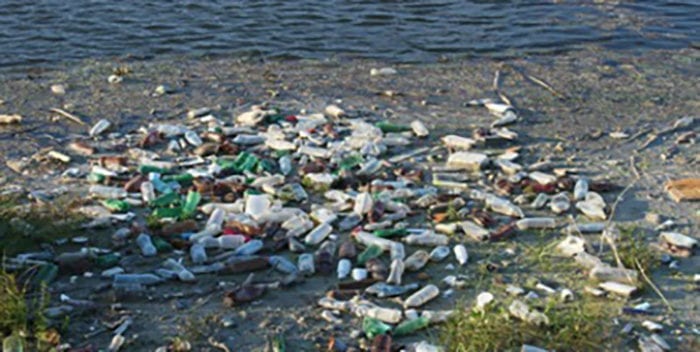
By Herb Herman
There appears to be no end to plastic. We use it, live with it, discard it and we can never rid ourselves of the stuff. It comes as food wrappers, bottles, toys, containers of all kinds, and is so pervasive that plastic is very much an omnipresent part of our world.
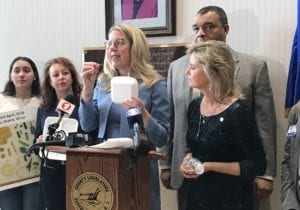
The numbers are staggering. More than 400 million tons of plastic are produced globally every year. And when we finish with plastic, we throw it out, try to recycle it, hide it in landfills, incinerate it, but, by far, most of the plastic debris we no longer have use for ends up in lakes, waterways and in the ocean. Some 80 percent of this litter comes from land sources, while 60-to-90 percent of beach litter is comprised of plastic. It is not encouraging to learn that Americans use approximately 100 billion single-use plastic bags annually, and around a trillion are used globally. The persistence of plastic waste is legendary, a plastic water bottle lasting 450 years. Much has been written of the plastic floating islands in the Pacific Ocean, and the apparently futile means to get rid of them. The National Geographic pleadingly offers us the “Planet or Plastic?” initiative, but the seemingly endless mass of plastic waste continues to grow like a cancer on the Earth.
If one were to carry out a literature search on plastic waste scientific publications the number of citations would exceed 450,000. The tangible impact of plastic waste is well documented. Most of the articles cited address the problem of plastic distribution around the world, from India to countries in the west, even the Antarctic, and at depths of 6,000 meters in the world’s oceans. Much research concentrates on sea animals and birds the world over, either through ingesting plastic particles or becoming tangled in plastic nets and fishing gear. Many of these plastics break down to fine, toxic particles leaving numerous bird species and sea animals with a high percentage of toxins in their guts.
Crustaceans and fish are well known to consume plastic particles. Since we eat these animals, we also eat plastics. The long-term health consequences of plastic ingestion on sea creatures and humans are still unknown. Enormous quantities of micro-sized particles of plastics from personal hygiene products get deposited in water systems and also float around the world as airborne pollutants. There appears to be no end of plastics in various forms proliferating the earth.
Of course, scientists are constantly seeking solutions. Landfills reach enormous proportions, with no guarantee that the waste plastics thus disposed of will remain where they are placed. Incineration is also used, sometimes to supply energy as a spin-off from the heat produced, but this approach leaves pollutants escaping into the environment. Of course, recycling appears to be the panacea for ridding ourselves of plastic. Unfortunately many plastic materials do not readily lend themselves to this gratifying solution, and recycling depends to a large measure on citizens acting responsibly, collecting candidate plastic products and properly disposing of them. Furthermore, those recyclable plastics that can be conveniently collected and segregated need to be sent to appropriate facilities for processing, and there are far too few of these plants. There will probably never be sufficient numbers of such facilities for the recycling of the vast quantities of plastics, which are continually produced.
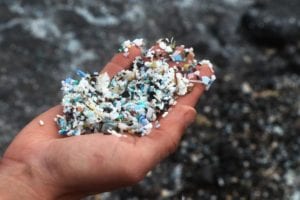
What then to do? One can clearly appreciate the great need that exists and the challenges faced by planners and engineers who are tasked with dealing with this overwhelming problem. Academies of sciences and governments the world over have met and discussed this global problem. Some plastic-producing industries have pledged to carry out manufacturing measures and use materials that would ensure plastics can indeed by readily recycled. Governmental organizations have outlawed the use of plastics bags, and even paper straw bans have been introduced. The use of single-use plastic bottles has been vigorously discouraged. Non-governmental organizations have made the public aware of the seriousness of the problem. The list goes on, but millions of tons of plastics continue to be produced annually, and beachgoers continue to use plastic utensils and fail to discard them responsibly.
It is imperative to formulate policies and mechanisms through which plastic litter can be controlled. For starters, the production of biodegradable, nontoxic plastics must be encouraged. A ban on single-use plastic bags should be incorporated in any waste-controlling legislation. Government research funds should be allocated for developing cost-effective chemical and mechanical recycling technologies, and perhaps most important is the education of the public on the matter of plastic’s effect on the marine ecosystem. The time has come to act to save the planet from this scourge of plastic.
Herb Herman is a distinguished professor emeritus from the Department of Materials Science and Engineering at Stony Brook University.



